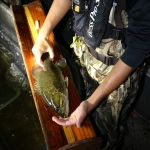Office of Applied Science FAQ
What is the mission of the Office of Applied Science (OAS)?
The OAS provides research and consultation services on statewide fish and wildlife priority issues. The OAS Leadership Team’s primary responsibilities are to ensure that the highest-priority research needs are met within the Fish, Wildlife and Parks Division, annual budgets and reports are developed and scientific consultation is provided to the agency. Our mission is to provide the best available science to the Division programs and staff to inform and support conservation and management decisions.
Where is the OAS positioned within the DNR?
In 2017, as part of the agency re-alignment process, the OAS was created to better align the fish and wildlife research and consultation functions with the programs we serve, including the Bureaus of Fisheries Management and Wildlife Management. OAS consists of an Office Director, a fish research team and a wildlife research team. Both teams have statewide responsibility for research activities. OAS staff are housed in offices across the state, including Madison (Science Operations Center), Boulder Junction (Escanaba Lake Research Station and Northern Highland Fishery Research Area), Rhinelander (Northern Wildlife Research Station), Dodgeville, Baldwin and Spooner.
The OAS has a total of 13 permanent positions: Ten NR Research Scientists, two NR Program Supervisors (Team Leaders) and one Section Chief (Office Director). In addition, OAS has 25-30 limited-term employees.
How is OAS research conducted and used?
Research projects address high-priority management and conservation needs and questions specific to the bureaus within the Fish, Wildlife and Parks Division. Information may be used by the Division to inform decision-making and manage fish and wildlife populations, including informing population and habitat management decisions and harvest-related policy needs.
Projects are undertaken in-house or in collaboration with research colleagues at state universities and federal and state agencies.
How is the OAS funded?
OAS is primarily federally funded through federal aid in the Sport-Fish Restoration Act (SFR) and the Federal Aid in Wildlife Restoration Act (PR), with additional support provided by State Conservation Segregated Fund dollars. OAS team leaders and scientists also secure additional federal and foundation funding through competitive grants to conduct high-priority fisheries and wildlife research for the agency where appropriate.
What consultation services does the OAS provide?
Requests for consultations are questions, issues or analyses that require scientific expertise but can be answered by compiling and evaluating previous research. Services vary from short-term requests (4-40 hours) to those lasting several months. They include:
- Analyses of fish and wildlife population trends and species harvest data
- Potential responses of fish/wildlife population to changes in harvest management
- Policies and assessments of the current literature on a specific management topic
OAS staff collectively spends nearly 50 percent of their time on consultation services and requests.
How are the research teams divided in the OAS?
Fish Research Team – Maintaining Fisheries Research staff at the Northern Highland Fishery Research Area in Boulder Junction, the Science Operations Center in Madison and the Spooner Service Center is critical since our fisheries research program and projects are statewide in scope. Having staff around the state also better aligns staff with regional fisheries managers’ needs.
Our collective expertise is diverse and includes staff who specialize in coldwater sport fishes, general fisheries ecology and management and quantitative fisheries stock assessment. Fisheries Research staff are engaged in high-priority research projects related to the sport fishes of Wisconsin (e.g., walleye, muskellunge, bass, panfish, trout, sturgeon), fish habitat and Bureau of Fisheries Management’s propagation program. To help meet research needs, the fisheries research team collaborates with State and Federal agencies, universities, anglers, state hatcheries, tribal partners and conservation groups.
Wildlife Research Team – The work of wildlife research staff aligns with the information needs of partner bureaus, with the Bureau of Wildlife Management being our primary customer. Our work is conducted statewide and is diverse in scope, with expertise spanning the broad diversity of wildlife across the state. Staff expertise includes wildlife population monitoring, harvest projection, disease ecology and population dynamics. Most wildlife research staff are located in Madison (Science Operations Center), Rhinelander (Northern Wildlife Research Station) and Eau Claire.
The Wildlife Research Team also provides opportunities for participation in science through hunter, trapper, landowner and public volunteer programs. We also foster collaborations with state and federal agencies, universities, tribal partners and conservation groups across the state and country to help meet high-priority research needs for the agency.



